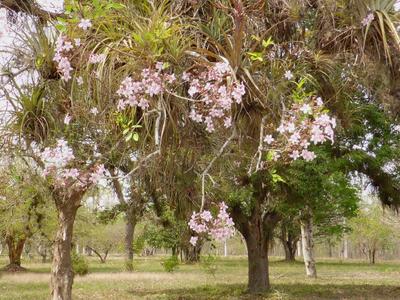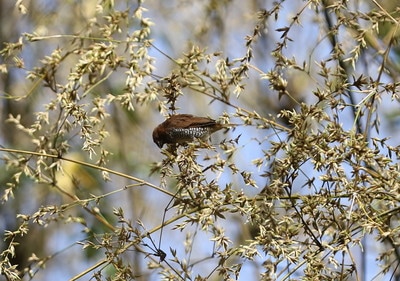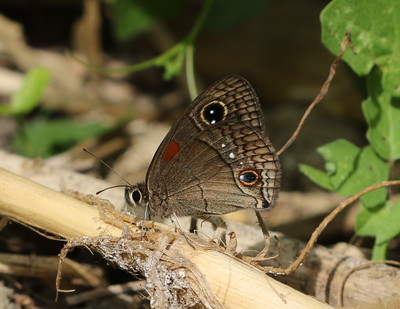|
Our friend Douglas arrived late last night on the bus from Camagüey to join us for the trip. It was great to catch up with news over breakfast. And then we were picked up by Donny's brother, Jose who was to be our driver for the next few days. We had visited Cienfuegos Botanic Garden once before on 2 March 2014 and knew that it had potential. On that occasion it had rained beforehand and the gardens had looked quite lush in places. Unfortunately that was not the case this time and everywhere was very dry which didn't bode well. The entrance road is lined with palms, and a large part of the area is managed like parkland with mown vegetation and scattered trees, some native but mainly of foreign origin. The effect is pleasing but it could be so much more I think. There is a small restaurant and several local guides who take groups of visitors around to show them things of interest. There are a large number of species of bamboo on display, some native and some not. Several near the restaurant had recently flowered and were seeding which attracted a mixed flock of Yellow-faced Grassquits and some other birds that I recognised as Munias but couldn't put a name to them. They are not in the Birds of Cuba but are clearly Scaly-breasted Munias. These seem to be spreading through the Caribbean from escaped cage-birds. There were a few butterflies including White Peacock Anartia jatrophae and Monk Skipper Asbolis capucinus. And also a couple of Calisto. The first is clearly Cuban Calisto Calisto herophile with its line of four white spots on the hindwing but the second has only three white dots and the median line is much straighter. I think it is most likely also herophile, perhaps of a different sex, there is so much more still to learn about these Calisto - there are additional species that have been discovered in Cuba but have not yet been described. If I was in charge (and had the budget) I would gear the gardens more to display the wonderful native trees and shrubs. Perhaps use it as a propagation centre too for the rare trees that have suffered heavily to logging in the last coupe of centuries with a view to carrying out a replanting programme much as Costa Rica has done in such a big way in recent years. And with a bit of thought given to planting, near the restaurant and elsewhere, of good nectar sources and larval foodplants there could be many more butterflies flying around even during the dry season. We wanted to look for two Hairstreak species that Doug had seen here on a previous occasion just under a year ago. We found neither unfortunately, though did find the foodplants of both. Calopogonium caeruleum (or coeruleum I'm not sure of the correct spelling) is the foodplant of the Amethyst Hairstreak Chlorostrymon maesites. The plant is a vigorous sprawling vine in the legume family. It was growing in a dry riverbed that crosses the site. Growing nearby was a large patch of Balloon-vine Cardiospermum halicacabum which is the foodplant of Silver-banded Hairstreak Chlorostrymon simaethis. We searched the flowers and balloon-like seed pods for some time looking for larvae without success. Ah well, another time. We had a very nice lunch in the restaurant where a very tame and obliging male American Redstart was hopping around and watched a Black-throated Blue Warbler picking insects from a spider's web. An American Kestrel was hunting insects and we saw and heard several Great Lizard Cuckoo including one that spent ages poking around amongst the epiphytes on a large tree occasionally checking on me to make sure that I didn't get too close. A freshly emerged female Phaon Crescent Phyciodes phaon was a nice find and there were several Barred Yellow Eurema daira of the form with a lot of orange scales underneath. During the afternoon we set off for our hotel for the next few nights, Hotel Hanabanilla up in the hills a little way to the north. Again we had stayed here for a couple of nights on our first visit so knew what to expect. Even up here they had had little rain for months so again it was much drier than we had hoped. After checking in we went out for a quick walk before supper through a small coffee plantation amongst the trees where Doug managed to find a couple of Caribbean Faceted Skipper Synapte malitiosa larvae on Pharus. The larvae are remarkably similar to Three-spotted Skipper Cymaenes tripunctus but have a very slightly different head pattern and tripunctus doesn't feed on Pharus.
0 Comments
Leave a Reply. |
Welcome to our Blog
Here we will post interesting news about what we and others have seen in Cuba. Archives
July 2024
Categories |



























 RSS Feed
RSS Feed